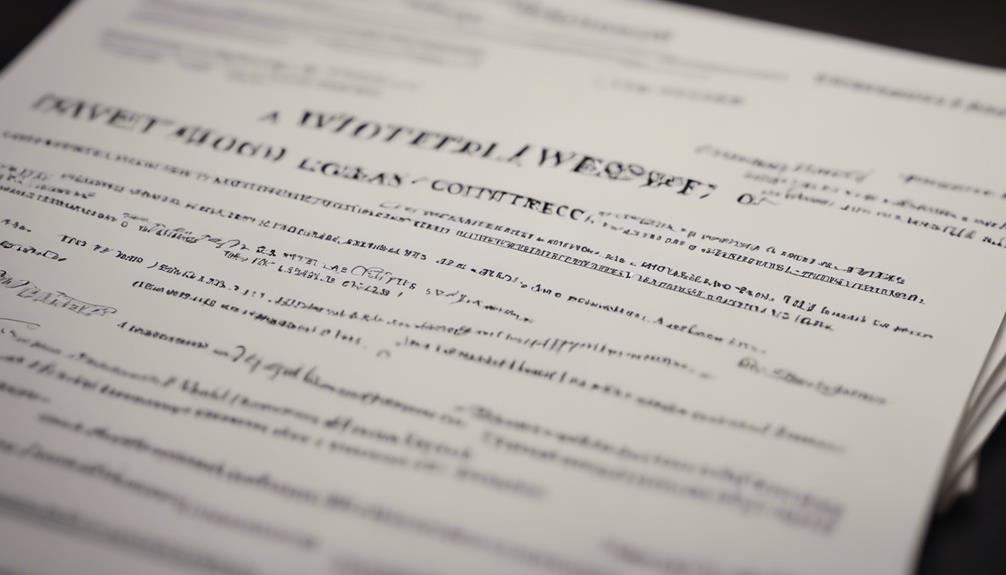Linguistic Features and Figurative Language
Mastering Figurative Language for Authors
Yearn to elevate your writing? Explore the power of figurative language for authors and unlock the secrets to captivating storytelling.

It is crucial for writers to have a good grasp of figurative language. It can enhance their work by adding depth and sparking creativity. Similes, which compare dissimilar things through the use of ‘like’ or ‘as,’ amplify descriptions. Metaphors produce striking visuals by transforming intricate ideas into vibrant images. Personification brings narratives alive, making characters more relatable. Hyperbole magnifies emotions, enchanting readers with overstated declarations. Comprehending symbols in literature adds intricacy to the narrative. Guidances for mastering figurative language can steer clear of usual mistakes. By getting acquainted with these literary tools, writers can allure readers and weave engaging stories.
Key Takeaways
- Figurative language enhances creativity and depth in writing.
- Similes compare unlike things using 'like' or 'as'.
- Metaphors create profound imagery and convey complex ideas.
- Personification brings narratives to life with human traits.
- Hyperbole amplifies emotions and situations for impactful storytelling.
Importance of Figurative Language
Exploring the significance of figurative language enhances our writing by infusing it with depth and creativity.
Figurative language, including similes and metaphors, allows us to paint vivid images in the minds of our readers.
By utilizing different types of figurative language, such as metaphors and similes, we can compare two seemingly unrelated things, adding layers of depth and richness to our writing.
Metaphorical language goes beyond the literal, enabling us to convey complex emotions and ideas in a way that straightforward language cannot.
Through the use of similes and metaphors, we can showcase creativity and evoke powerful imagery that resonates with our audience.
Figurative language serves as a powerful tool for authors to express themselves in a unique and engaging manner, elevating the quality and impact of their written work.
Exploring Similes in Writing

Similes, powerful tools in writing, vividly compare unlike things using 'like' or 'as' to create engaging imagery for readers. They play an important role in figurative language, allowing writers to make comparisons that help readers visualize scenarios more effectively.
By highlighting similarities between two disparate entities, similes aid in enhancing understanding and adding depth to descriptions. For instance, the simile 'Her smile was as bright as the sun' not only paints a vivid picture but also evokes emotions tied to the brightness and warmth of the sun.
Writers use similes strategically to engage readers and evoke specific feelings, making the writing more impactful and memorable. Through the use of similes, writers can craft descriptive passages that resonate with readers, creating a more immersive experience that enhances the overall quality of their work.
Mastering Metaphors for Impact

Moving from the comparison tool of similes, we now shift our focus to mastering metaphors for impactful and profound writing. Metaphors directly compare unlike things, weaving powerful imagery and deeper meanings into our literary tapestry. Unlike similes, which use 'like' or 'as', metaphors create a direct relationship between two unrelated concepts, distilling complex ideas or emotions into a single, vivid image that resonates with readers.
By merging these unlike elements, metaphors not only simplify intricate notions but also evoke strong emotions and captivate audiences on a profound level.
Employing metaphors in writing enhances descriptions, adds layers to storytelling, and imprints lasting impressions on readers. Mastering the art of metaphors involves strategic usage to convey complex ideas, amplify themes, and craft memorable literary experiences. Through the skillful deployment of metaphors, authors can immerse readers in a world where words paint vibrant pictures, emotions run deep, and engagement is heightened to new levels of appreciation.
Enhancing Writing With Personification

Enhancing our writing with personification breathes life into our narratives. It infuses inanimate objects and abstract concepts with human qualities that captivate readers.
Personification is a powerful figurative language technique. It attributes human traits to non-human entities, transforming them into relatable characters within our stories.
This technique is commonly utilized in fables, myths, and children's literature. It creates vibrant and memorable narratives that resonate with readers of all ages.
Harnessing the Power of Hyperbole

Harnessing the Power of Hyperbole allows writers to amplify emotions and situations beyond reality, mesmerizing readers with exaggerated statements that make a lasting impact.
Hyperbole, a form of figurative language, leverages exaggeration to emphasize and enhance the essence of a story. By employing hyperbole effectively, authors can infuse their writing with a sense of drama, humor, or intensity, captivating audiences with over-the-top expressions.
This tool is particularly impactful in storytelling, where it can underscore key emotions, actions, or ideas, making them more engaging and memorable for readers. Understanding the art of hyperbole is essential for authors aiming to master figurative language, as it enables them to create vivid and compelling narratives that leave a lasting impression on their audience.
Understanding Symbolism in Literature

Delving into the realm of literature, we uncover the intricate web of symbolism, where words transcend their literal meanings to embody profound ideas and emotions.
- Symbolism in literature: It involves exploring symbols to represent abstract ideas or concepts.
- Deeper meanings: Symbols can be objects, actions, or images that have meanings beyond their literal interpretation.
- Author's tool: Authors use symbolism to add layers of complexity, convey themes, and evoke emotions in their writing.
- Interpreting significance: Understanding symbolism requires analyzing the context in which symbols are used and interpreting their significance.
Authors employ symbolism to enrich their work, allowing readers to delve into layers of complexity and discover the deeper meanings hidden within the text. By carefully crafting symbols that convey themes and evoke emotions, authors invite readers to interpret the significance of these symbols, adding a new dimension to the reading experience. Symbolism not only enhances the depth of literary works but also challenges readers to explore abstract ideas and concepts woven into the narrative.
Tips for Figurative Language Mastery

As we explore the domain of figurative language mastery, a key aspect to focus on is the effective use of similes to create vivid descriptions and enhance visualization. Similes compare two unlike things using 'like' or 'as,' allowing for enhanced imagery in your writing. Metaphors, on the other hand, directly equate unrelated concepts, adding depth and emotion to your work. They offer a powerful way to convey complex ideas in a more engaging manner.
When incorporating personification, non-human entities are given human qualities, creating engaging narratives that readers can emotionally connect with. Hyperbole, through its exaggerated statements, adds emphasis and memorability to your writing. Additionally, idioms can enhance professionalism and infuse cultural expressions into your style, enriching the overall reading experience.
| Figurative Language | Description | Benefits |
|---|---|---|
| Similes | Compare unlike things using 'like' or 'as' | Create vivid descriptions |
| Metaphors | Equate unrelated concepts directly | Add depth and emotion to your writing |
| Personification | Give human qualities to non-human entities | Create engaging narratives |
Common Mistakes to Avoid

In mastering figurative language, it's crucial to be mindful of common mistakes to sidestep, guaranteeing clarity and impact in your writing. Here are some key pitfalls to watch out for:
- Mixing Metaphors: Combining unrelated metaphors can confuse readers and weaken the impact of each one.
- Cliches: Using overused phrases can make your writing appear unoriginal and uninspired.
- Overusing Similes: Excessive similes and metaphors can overwhelm readers, distracting them from your message.
- Inappropriate Comparisons: Be cautious with comparisons that may be insensitive or offensive, as they can alienate your audience.
To maintain authenticity and maximize the impact of your figurative language, avoid forcing it into your writing. Let it flow naturally, enhancing rather than overshadowing your voice.
Frequently Asked Questions
How Do You Master Figurative Language?
To master figurative language, we immerse ourselves in varied literary works to grasp the nuances of similes, metaphors, personification, hyperbole, and more. Seeking feedback from peers and mentors helps identify areas for improvement.
Experimenting with different genres and styles broadens our skills. Online resources and writing tools dedicated to figurative language enhance understanding.
Through practice, feedback, and exploration, we refine our ability to wield figurative language effectively.
How Can Authors Use Figurative Language?
Authors can use figurative language to enhance their writing in various ways. Similes compare unlike things using 'like' or 'as', adding vivid descriptions. Metaphors directly compare unrelated concepts to deepen meaning.
Personification assigns human traits to objects for emotional depth. Hyperbole exaggerates for emphasis, creating memorable expressions. Incorporating these tools helps engage readers, evoke emotions, and elevate the overall quality of our writing.
How Do You Teach Figurative Language in Writing?
When teaching figurative language, we start by explaining similes, which compare unlike things using 'like' or 'as' for vivid descriptions.
Metaphors follow, directly comparing ideas without 'like' or 'as' for powerful images.
Then we introduce personification to give non-human things human qualities for engaging storytelling.
Hyperbole is emphasized for exaggeration, intensifying emotions.
Practice and experimentation help writers grasp and use these tools effectively in their writing for impactful storytelling.
What Are the 5 Types of Figurative Language?
There are five types of figurative language:
simile, metaphor, personification, hyperbole, and alliteration.
Simile compares using 'like' or 'as'; metaphor directly equates unrelated concepts; personification gives human traits to non-humans; hyperbole exaggerates for emphasis; alliteration repeats consonant sounds.
Each type adds depth and vividness to writing, enhancing storytelling and engaging readers. Understanding and mastering these tools can elevate our writing to new levels of creativity and impact.
How Can Figurative Language in Songs Help Authors Master Their Craft?
The roles of figurative language in songs are crucial in helping authors master their craft. By utilizing metaphors, similes, and other figurative elements, songwriters can evoke powerful emotions and create vivid imagery in their lyrics. This can enhance the storytelling aspect of their writing and make their songs more engaging and impactful.
Conclusion
In mastering figurative language, authors can elevate their writing to new heights. By incorporating similes, metaphors, personification, hyperbole, and symbolism, writers can create vivid imagery and evoke powerful emotions in their readers.
Remember, figurative language adds depth and complexity to your writing, making it more engaging and memorable. So, don't be afraid to experiment and play with different figures of speech to enhance your storytelling.
Happy writing!
Boaz, Founder and Chief Editor – With a profound linguistics and anthropology background, founded What Does Meanings to explore the intricate connections between language, symbols, and cultural identity. His vision has guided the platform from its inception, ensuring that each piece of content enriches our understanding of the world’s symbolic heritage.
Linguistic Features and Figurative Language
Beginner's Guide to Decoding OSS Meaning
Uncover the hidden depths of 'Oss' in martial arts, exploring its historical roots and cultural significance, shedding light on its profound meaning.

Oss carries deep ties to samurai and naval traditions, showcasing strength, respect, and discipline. It comes from Japanese expressions like ‘Oshi shinobu shinobu,’ symbolizing values found in modern martial arts. In Brazilian Jiu-Jitsu, **Oss** means agreement, readiness, and respect, showing mental toughness and community. Over time, it blends traditions and innovations, highlighting perseverance and acknowledgment. Knowing its roots and cultural meanings deepens appreciation. Dive into the unique world of martial arts to uncover the many layers of **Oss** and its rich significance. More insights await into this fascinating topic.
Key Takeaways
- 'Oss' symbolizes strength, respect, and discipline in martial arts.
- Originates from Japanese traditions like Oshi shinobu and ony shimasu.
- Represents agreement, endurance, and historical samurai values.
- Used in Brazilian Jiu-Jitsu to acknowledge, respect, and show readiness.
- Embodies mental toughness, interconnectedness, and cultural exchange in martial arts.
Origins of 'Oss' and Its Significance
We uncover the fascinating origins of 'Oss' and explore its profound significance in martial arts.
The word 'Oss' traces its roots back to Japanese expressions such as Oshi sinobu shinobu and ony shimasu, symbolizing historical samurai and naval traditions. This term has come full circle, embodying enduring under pressure, summoning crucial energy, and signifying formal agreement in various martial arts contexts. Yamamoto Tomo, a revered samurai of The Saga Clan, used 'Oss' as a positive affirmation encompassing strength, respect, honor, and discipline. Through generations, the legacy of 'Oss' has been passed down, transcending historical boundaries to symbolize stoicism and endurance.
In martial arts, 'Oss' holds immense significance, representing respect, perseverance, and acknowledgment. It embodies traditions of formal agreement and attentiveness, emphasizing the importance of staying grounded and focused. Saying 'Oss' serves as a reminder to allow us to stay committed to our training, to keep pushing forward even in challenging times. This simple word carries a wealth of meaning and wisdom, enriching the martial arts journey for all practitioners.
Historical Evolution in Martial Arts

During the historical evolution of martial arts, significant changes have shaped the practices and traditions of various disciplines worldwide. As martial arts developed over centuries, influences from diverse cultures and historical events have contributed to the rich tapestry of techniques and philosophies we see today. Below is a table highlighting key milestones in the historical evolution of martial arts:
| Time Period | Milestone | Impact |
|---|---|---|
| Ancient Times | Development of basic combat techniques | Foundation for future martial arts |
| Feudal Japan | Formation of distinct martial arts styles | Samurai traditions influence practices |
| Modern Era | Globalization of martial arts through media and travel | Exchange of techniques and ideas |
This evolution showcases how martial arts have adapted and transformed over time, blending traditions and innovations to create a dynamic and diverse landscape of combat disciplines. Understanding this historical journey can provide deeper insights into the essence and significance of martial arts practices today.
Cultural Interpretations and Traditions

From the historical evolution of martial arts, the cultural interpretations and traditions surrounding 'Oss' provide a fascinating insight into the significance of this term in combat disciplines. The origins of 'O' and 'Oss' trace back to samurai culture and naval traditions, where Yamamoto Tomo, a samurai of The Saga Clan, used 'Oss' as a positive affirmation.
In martial arts, these terms symbolize respect, perseverance, and acknowledgment, carrying deep historical significance. The use of 'Oss' in Brazilian Jiu-Jitsu showcases the blending of Japanese and Brazilian martial arts traditions, highlighting the rich cultural exchange within the discipline.
Understanding the cultural interpretations of 'Oss' enhances our appreciation for its role in martial arts practices. As martial arts have evolved, incorporating gestures like 'Os' and clapping for respect and agreement in Brazilian Jiu-Jitsu reflects the evolution of traditions towards informal practices while still upholding the core values of respect and perseverance.
Embracing these cultural interpretations adds depth to our understanding of the martial arts world and the values it embodies.
Modern Usage in Brazilian Jiu-Jitsu

In Brazilian Jiu-Jitsu, the term 'Oss' serves as a versatile expression that signifies acknowledgment, readiness, and respect among practitioners. The integration of 'Oss' in BJJ showcases the cross-cultural influences between Japanese and Brazilian martial arts traditions.
Here are some key points regarding the modern usage of 'Oss' in Brazilian Jiu-Jitsu:
- Acknowledgment: 'Oss' is commonly used in BJJ as a sign of acknowledgment and agreement between practitioners.
- Readiness: In BJJ, 'Oss' is also used to summon energy and show readiness for challenges.
- Respect: 'Oss' is a way for practitioners to express respect towards their training partners.
- Mental Toughness: Practitioners use 'Oss' to embody resilience, mental toughness, and a strong work ethic during training sessions.
- Interconnectedness: The usage of 'Oss' in BJJ emphasizes the interconnectedness and evolution of martial arts practices within a specific training context.
Exploring Practical Applications and Etiquette

Exploring the practical applications and etiquette surrounding the use of 'Oss' in martial arts reveals a tradition deeply rooted in respect, perseverance, and mental fortitude. In traditional martial arts settings, 'O' and 'OSS' are employed to demonstrate respect and acknowledgment during training sessions. By incorporating these expressions, practitioners signify agreement, perseverance, and understanding, embodying the core values of martial arts training. The use of 'OSS' reflects a cultural emphasis on discipline, respect, and mental strength, providing a framework for negotiating the formalities and etiquette of martial arts environments.
Understanding the significance of 'O' and 'OSS' is essential for beginners seeking to immerse themselves in martial arts traditions. By embracing these expressions in their practice, individuals can internalize the values of respect, perseverance, and readiness for challenges that are integral to the martial arts journey. As practitioners work towards mastery, the use of 'OSS' serves as a constant reminder of the principles that underpin their training, fostering a culture of respect and dedication within the martial arts community.
Frequently Asked Questions
What Is the Meaning of Oss?
Oss is a term originating from Japanese martial arts, embodying respect, perseverance, and acknowledgment. It symbolizes endurance under pressure and formal agreement, passed down through generations from samurai culture.
In Brazilian Jiu-Jitsu, 'Oss' signifies readiness for challenges and blends Japanese and Brazilian martial arts traditions. Encouraging resilience, mental fortitude, and hard work, 'Oss' represents strength, honor, and discipline in martial arts contexts.
What Does OSS Slang Mean?
OSS is a term widely used in Brazilian Jiu-Jitsu to convey respect, agreement, and readiness for training or challenges. Originating from Japanese martial arts, it symbolizes perseverance and never giving up.
In BJJ culture, shouting 'OSS' during sessions or competitions shows appreciation for techniques. This term reflects the discipline and respect within martial arts, emphasizing mental strength and commitment.
Understanding its meaning helps beginners navigate BJJ's etiquette, culture, and community camaraderie.
What Does OSS Mean in Muay Thai?
In Muay Thai, 'OSS' isn't commonly used as it's more associated with Japanese martial arts. Traditional Thai greetings like the 'Wai' or 'Sawasdee' are preferred for showing respect.
Muay Thai focuses on techniques, conditioning, and Thai cultural traditions. While 'OSS' isn't part of Muay Thai vocabulary, respect and discipline are ingrained in the art.
What Does OSS Mean in Anime?
In anime, 'OSS' is a powerful term symbolizing respect, determination, and unity among characters. Used in martial arts-themed shows, it embodies discipline and camaraderie, often heard during training or intense moments.
'OSS' showcases the influence of Japanese martial arts etiquette, highlighting themes of honor and perseverance. Understanding its significance in anime deepens appreciation for the values portrayed in martial arts narratives, enhancing the storytelling experience for viewers.
What Does OSS Mean and How is it Related to MRD?
OSS stands for Operations Support System, and it is related to MRD, which stands for Market Requirements Document. OSS is crucial in decoding MRD understanding meaning, as it helps in effectively managing the telecom network operations to meet the market requirements outlined in the MRD.
Conclusion
To sum up, decoding the meaning of 'Oss' provides valuable insights into its historical roots and cultural significance in martial arts.
By understanding its evolution and practical applications, we gain a deeper appreciation for this traditional term.
So next time you hear 'Oss' in the context of Brazilian Jiu-Jitsu, remember its rich history and embrace its role in promoting respect and discipline.
Let's continue to honor this tradition with reverence and humility.
Robert, Research Specialist—Robert specializes in visual explorations and brings a keen eye for detail to our research team. He delves into the historical and cultural backgrounds of symbols to present deeply researched content beautifully, making the old and mystical accessible to a modern audience.
Linguistic Features and Figurative Language
Meaning of GPI in Spanish
Wondering what 'GPI' means in Spanish? Unveil the secret behind this acronym and discover its significance in social interactions.

In Spanish, ‘**GPI**’ stands for ‘**Gracias por invitar**,’ which means ‘**thanks for inviting.’** Friends say it to show they appreciate being invited to hang out. Using ‘**GPI**’ makes chats quick and easy, keeping things fun and casual. Knowing about ‘**GPI**’ can help a lot in Spanish conversations, making you seem polite and friendly. There’s a whole world of cool facts about where ‘**GPI**’ came from and how people use it, ready to be discovered!
Key Takeaways
- GPI stands for 'Gracias por invitar' in Spanish.
- It is used informally to express gratitude for invites.
- GPI is common in casual Spanish conversations.
- Reflects appreciation for social inclusion.
- Enhances communication by showing gratitude succinctly.
Definition of GPI in Spanish
In Spanish slang, the abbreviation 'GPI' commonly signifies 'Gracias por invitar,' translating to 'Thanks for the invite.' When someone uses 'GPI,' it's a casual way of showing appreciation for being included in social events. Among friends and peers, 'GPI' is a quick and informal method to express gratitude for being invited to a party or gathering. Understanding this abbreviation is essential for smoothly managing informal Spanish conversations and social interactions.
When you see 'GPI' in a message from a Spanish-speaking friend, it's their way of saying 'Te quiero mucho' in a light-hearted manner. It's like a little thank you note for thinking of them and inviting them to join in on the fun. So, next time you receive a 'GPI' in your chat, remember to reciprocate the sentiment and keep the positive vibes flowing in your social circle.
Origins of the GPI Abbreviation

Exploring the origins of the 'GPI' abbreviation, its roots in informal Spanish communication become clearer.
The abbreviation 'GPI' originated within Spanish texting slang as a convenient way to express gratitude. Within this framework, 'GPI' stands for 'Gracias por invitar,' which translates to 'Thanks for inviting.'
This abbreviation reflects the casual and friendly tone often found in digital communication among friends and peers. As texting has become a prevalent form of interaction, abbreviations like 'GPI' have emerged to streamline messages while maintaining a sense of appreciation.
By understanding the origins of 'GPI' and its use in informal Spanish settings, individuals can navigate conversations more effectively. Embracing texting slang like 'GPI' can enhance communication skills and foster stronger connections within social circles.
The evolution of such abbreviations highlights the dynamic nature of language and the adaptability of communication methods in contemporary society.
Usage of GPI in Informal Spanish
In informal Spanish texting, the abbreviation 'GPI' is commonly used to express a sense of disappointment at not being invited. This playful and teasing phrase reflects a desire to be included in social events among peers.
Variations of this abbreviation may exist regionally, adding to the cultural nuances of its usage.
Common GPI Phrases
Often used in casual conversations among Spanish-speaking youth, the abbreviation GPI stands for 'Gracias Por Invitar' and conveys a playful sense of disappointment at not being invited to an event. When friends use GPI, they playfully express feelings of exclusion and a desire to be included in social activities. This informal phrase is commonly seen as teasing or light-hearted banter among peers. The abbreviation GPI is a way to question why one wasn't included in a fun gathering, adding a touch of humor to the situation.
- Playful expression of disappointment
- Desire to be included in social activities
- Teasing or light-hearted banter
Regional Variations
Exploring regional variations in the usage of GPI in informal Spanish reveals intriguing nuances in how different Spanish-speaking communities interpret and employ this abbreviation.
In some regions, the abbreviation 'GPI' for 'Gracias Por Invitar' is widely recognized and frequently used in casual conversations to humorously express disappointment at not receiving an invitation. This playful expression of feeling left out resonates particularly among young people, highlighting a desire for inclusion in social activities.
While the concept of feeling excluded is universal, the specific use of 'GPI' to address this sentiment may vary slightly in different Spanish-speaking areas. Understanding these regional differences can enrich one's grasp of informal Spanish communication and help navigate online interactions effectively.
Common Contexts for GPI

Let's talk about the common contexts for GPI.
We'll explore the uses of GPI, the cultural significance it holds, and the challenges of translating this slang term.
Understanding these points will shed light on how GPI is employed and its impact in social interactions.
Uses of GPI
In informal settings among young Spanish speakers, the abbreviation 'GPI' is commonly used to express disappointment or frustration for not being invited to an event or party. When texting in Spanish, this acronym serves as a playful way to convey a desire for inclusion. Its usage reflects a teasing tone, often expressing a sense of exclusion informally.
The abbreviation 'GPI' stands for 'Gracias Por Invitar,' translating to 'Thanks for inviting' in English.
- Expressing disappointment or frustration
- Conveying a desire for inclusion
- Reflecting a playful or teasing tone
Cultural Significance of GPI
Moving from the uses of GPI, understanding the cultural significance of this abbreviation sheds light on its common contexts in informal Spanish language interactions.
In informal settings among young people, 'GPI' commonly stands for 'Gracias Por Invitar,' conveying a sense of disappointment for not being invited. This playful or teasing abbreviation reflects a desire to be included in social activities, often used to express frustration in a light-hearted manner.
Native speakers use 'GPI' to playfully show their feelings of exclusion, adding a humorous twist to conversations. Recognizing the cultural significance of 'GPI' is essential for interpreting informal Spanish language interactions accurately.
As language evolves, slang terms like 'GPI' become integral in expressing emotions and maintaining cultural connections among speakers.
Translation Challenges for GPI
Understanding the translation challenges for 'GPI' involves unraveling its nuances within different cultural contexts. When it comes to translating 'GPI' from Spanish to English, there are several language-specific considerations to keep in mind.
- Native Spanish: Ensuring the message retains its cultural essence in the target language.
- Language Skills: Balancing linguistic accuracy with conveying the intended meaning effectively.
- Thanks for Inviting: Capturing the subtle blend of disappointment and humor inherent in the phrase.
Mastering the translation of 'GPI' requires a deep understanding of both languages involved, as well as familiarity with the cultural implications of the expression. By honing your language skills and cultural awareness, you can successfully navigate the challenges posed by translating 'GPI' for different audiences.
Examples of GPI in Conversations

Let's look at how 'GPI' is used in everyday conversations among friends and peers. When a friend invites you to a party, and you want to express gratitude, you can simply reply with 'GPI' to say 'Gracias Por Invitar' or 'Thanks for the invite.'
This abbreviation is commonly seen in informal chats or social media exchanges, reflecting a friendly and appreciative tone. For instance, if a friend sends you a message saying, 'Hey, we're having a barbecue this weekend, would you like to join?' You can respond with 'GPI! I'd love to come, thanks for the invite.'
Importance of Understanding GPI

Upon recognizing the prevalence of 'GPI' in informal Spanish communication, one can appreciate its significance in expressing gratitude and acknowledgment. Understanding this texting slang is vital for grasping the nuances of informal interactions among native Spanish speakers.
Here are three reasons highlighting the importance of understanding 'GPI':
- Enhanced Communication: Being aware of 'GPI' allows for a smoother and more culturally attuned exchange with Spanish speakers, especially in informal settings.
- Cultural Insight: Knowledge of 'GPI' offers a glimpse into the texting slang commonly used by native speakers, providing a deeper understanding of their communication style.
- Politeness and Friendliness: Saying 'GPI' reflects politeness and friendliness in a concise manner, showing appreciation for invitations in a casual yet respectful way.
Frequently Asked Questions
What Does GPI Mean in Mexican Slang?
GPI in Mexican slang means 'Gracias Por Invitar,' conveying disappointment for not receiving an invitation. It's commonly used informally, expressing a playful or teasing tone when questioning why one wasn't included in social activities.
The abbreviation reflects a desire for inclusion and is a way to express feeling left out among friends. Overall, GPI is a lighthearted way to convey disappointment for not being invited.
What Is LOL in Spanish Slang?
We often use 'jaja' or 'jeje' in Spanish slang to express laughter in online chats. Derived from the Spanish pronunciation of 'ha,' these terms mimic the sound of laughter.
Repetitive use, like 'jajaja,' indicates increasing levels of amusement. In informal texting, 'jaja' is a quick and universal way to convey humor.
Understanding this slang adds a playful tone to online conversations, making them more enjoyable and engaging.
What Is the Shorthand for Por Favor?
The shorthand for 'por favor' in Spanish is 'pf.' It's commonly used in informal conversations to politely request something.
Knowing abbreviations like 'pf' is essential for efficient communication in Spanish text messages. Using 'pf' saves space and quickly conveys a polite ask. Incorporating it in your messages demonstrates familiarity with Spanish texting etiquette.
What Does Aki Mean in Spanish Slang?
Aki, a Spanish slang term meaning 'here,' is commonly used by Spanish speakers in text messages and casual conversations. It's a shortened form of the word 'aquí' and is a quick way to indicate a location or presence informally.
Understanding 'aki' helps in decoding informal Spanish texts and adding a touch of colloquialism to written interactions. So, knowing its meaning can enhance your grasp of Spanish slang.
What is the Spanish equivalent of “heat” or “hot”?
In Spanish, the equivalent of “heat” or “hot” is “caliente.” Having an understanding of the caliente meaning can help unlock effective communication in Spanish-speaking communities.
Conclusion
To sum up, understanding the meaning of GPI in Spanish is vital for effective communication. It's a common abbreviation used in informal conversations, originating from the Spanish language.
Knowing the context in which GPI is used can help avoid confusion and misinterpretation. So, next time you come across GPI, remember it's as essential as breathing air.
Stay informed, stay connected, and keep learning!
Vanice, Content Director – Vanice, armed with extensive knowledge in linguistics, oversees the curation of all content on What Does Meanings. She ensures that every article, video, and guide is informative, engaging, and accessible to audiences of all backgrounds. Her editorial direction keeps our content relevant and enlightening.
Linguistic Features and Figurative Language
Understanding the Meaning of 'In Witness Whereof' in Legal Documents
Begin unraveling the significance of 'In Witness Whereof' in legal documents, a key element ensuring authenticity and validity, with compelling insights to follow.

In legal papers, **’In Witness Whereof’** plays a crucial role. It means witnesses were present when the agreement was signed, securing **authenticity**, **validity**, and the roles of signatories. This old phrase boosts contract **credibility** and enforceability. Its history underlines the need for outside validation; modern variations still hold importance. Notary publics help verify documents, crucial for **document integrity** and dispute resolution. Witness testimony ensures documents are real, clarifies ideas, and checks transactions are open and honest. This phrase is **vital** in legal tasks, protecting the integrity of legal processes. **Curious for more details?** Keep reading to dive deeper into the world of legal document intricacies.
Key Takeaways
- Signifies presence of witnesses during document execution
- Establishes authenticity and validity of agreements
- Clarifies role of signatories as witnesses
- Essential for legal compliance and credibility
- Ensures document integrity and resolves disputes
Importance of 'In Witness Whereof'
Understanding the significance of 'In Witness Whereof' is essential in recognizing the importance of this phrase in legal documents such as contracts. When parties include this term, they're indicating the presence of witnesses during the execution of the document. This simple phrase plays a pivotal role in establishing the authenticity and validity of legal agreements. It also serves to clarify the role of signatories as witnesses in the context of contracts.
Legal Implications of the Phrase

Including the phrase 'In Witness Whereof' in legal documents carries significant legal weight.
It helps establish the validity of the document, authenticate the signatory, and highlight the importance of proper execution.
These implications underscore the commitment to legal compliance and the clarity necessary for resolving potential disputes.
Legal Validity Implications
In legal documents, the presence of the phrase 'In Witness Whereof' holds significant implications for the legal validity and enforceability of contracts. This phrase serves to solidify the authenticity of the document, thereby enhancing its legal standing. By including 'In Witness Whereof' when signing a legal document, parties can help prevent misunderstandings and disputes over the terms outlined in the contract. The table below illustrates the key legal validity implications associated with the use of this phrase:
| Legal Validity Implications | Importance |
|---|---|
| Enhances enforceability | Strengthens legal standing and authenticity of the contract. |
| Prevents misinterpretation | Clarifies the intentions of parties involved, reducing potential conflicts. |
| Protects rights and obligations | Safeguards the interests of all parties entering into the agreement. |
| Impact on court proceedings | Can influence legal outcomes and the resolution of disputes. |
| Strengthen contractual relationships | Helps maintain trust and clarity between involved parties. |
Signatory Authentication Importance
Establishing the legitimacy of signatures, the presence of the phrase 'In Witness Whereof' in legal documents underscores the importance of signatory authentication. By including this declaration, the document confirms that witnesses were present during its execution, ensuring the authenticity and validity of the signatures. This phrase serves to clarify the role of signatories as witnesses to the agreement, emphasizing their responsibility in attesting to the document's contents.
Signatory authentication is essential for upholding legal formalities and compliance, as it provides a clear record of the parties involved in the agreement. In legal proceedings, the presence of witnesses can be instrumental in resolving disputes and offering concrete evidence to support the validity of the document.
Document Execution Significance
The significance of the phrase 'In Witness Whereof' in legal documents lies in its affirmation of the signer's role as a witness to the document's execution, ensuring the authenticity of signatures. By including this phrase, the credibility of the signatories involved is established, indicating the presence of witnesses during the execution process. This statement provides clarity on the signatories' roles as witnesses, emphasizing their responsibility in validating the document.
In the legal domain, the phrase 'In Witness Whereof' holds vital importance in confirming the legitimacy of signatures and the overall execution of the document. Its inclusion serves as a formal declaration that the signatories have witnessed and authenticated the contents of the legal document, adding a layer of assurance and validity to the proceedings.
Significance in Contractual Agreements

Understanding the importance of 'In Witness Whereof' in contractual agreements is essential for ensuring the validity and integrity of the document. This phrase is used to signify the presence of witnesses during the signing of legal documents. By including 'In Witness Whereof' in a contract, parties declare that their signatures have been witnessed, which enhances the credibility and authenticity of the document.
It demonstrates a commitment to legal formalities and compliance, establishing a clear record of the agreement. In contractual agreements, the presence of this phrase is significant for clarifying the role of witnesses and can help resolve disputes that may arise during legal proceedings. When entering into a contract, ensuring that 'In Witness Whereof' is included not only upholds the integrity of the agreement but also provides a level of assurance and legal standing that can be crucial in case of any future disagreements.
Role of Witnesses in Legal Documents

Witnesses play an essential role in legal documents by observing and attesting to the authenticity of signatures. Their presence adds an extra layer of verification and credibility to the document.
In case of disputes, witnesses can help confirm the validity of the legal transaction.
Witness Signature Importance
In legal documents, the presence of witnesses serves to validate the authenticity of signatures and confirm the execution of the agreement. Witness signatures play an important role in providing independent confirmation of the parties' agreement. These witnesses must meet specific criteria, such as being impartial, of legal age, and mentally competent.
Their signature adds credibility to the document and can be essential in resolving disputes. Including witnesses in legal documents not only strengthens the document's legal standing but also enhances its enforceability. As a result, the significance of witness signatures can't be overstated in ensuring the validity and integrity of legal agreements.
Witness Verification Process
During the signing process of legal documents, witnesses play an essential role in verifying the identities and presence of the signing parties. Their responsibility is to provide independent verification of the authenticity of the signatures and the document's execution. Witnesses must be impartial individuals not directly involved in the agreement, validating the parties' intent.
In some jurisdictions, witnesses may need to sign legal documents, enhancing their validity and enforceability. By having witnesses present, an extra layer of credibility is added to confirm that the document's execution is properly witnessed and acknowledged. This verification process is vital in upholding the phrase 'In witness whereof' and establishing the validity of the document.
Legal Document Validity
Ensuring the legal validity and enforceability of documents often hinges on the presence and verification provided by impartial witnesses. In legal documents, witnesses serve a critical role by attesting to the identities of signing parties and the authenticity of the document. Their presence during the signing process is essential for verifying the integrity of the contract and providing evidence of its execution.
In some jurisdictions, witnesses play a significant role in guaranteeing the document's legal validity. The acknowledgment and signature of witnesses add an extra layer of credibility and assurance to the terms and conditions outlined in the contract. As a result, the inclusion of witnesses in legal documents, as part of the 'In Witness Whereof' clause, enhances the document's reliability and standing in legal matters.
Historical Context of the Expression

Originally stemming from the Latin phrase 'in testimonium', the expression 'In Witness Whereof' has a rich historical context in legal documentation. This phrase has evolved over time, from its Middle English origins to its current usage in modern legal documents. Here are four key points to deepen your understanding of its historical significance:
- Third-party Witnessing: Initially, 'In Witness Whereof' indicated the presence of witnesses in contracts and other legal agreements.
- Evolution of Meaning: Over time, the phrase shifted to signify the parties' acknowledgment and affirmation of the contents of the document they're signing.
- Historical Roots: Its Latin origins highlight the importance of external validation and verification in legal proceedings.
- Continued Relevance: Despite its ancient roots, 'In Witness Whereof' remains an essential element in modern legal language, emphasizing the authenticity and validity of legal documents.
Understanding this historical context provides insight into the enduring importance of 'In Witness Whereof' in legal documentation.
Understanding 'In Witness Whereof' Variations

In legal documentation, understanding the variations of 'In Witness Whereof' is essential for maintaining clarity and consistency. Variations such as 'In witness hereof,' 'In testimony whereof,' 'In token whereof,' 'In proof whereof,' and 'In evidence whereof' serve the same purpose as the original phrase in legal documents.
The choice of variation is usually a matter of personal preference for the drafter of the document. Consistency in using a specific variation is vital for ensuring clarity and uniformity in legal language. It's important to note that using different variations of 'In Witness Whereof' doesn't alter the legal significance of the phrase.
When drafting legal documents, it's advisable to select one variation and maintain its use throughout the document to avoid confusion and maintain professionalism. Familiarizing oneself with these variations can enhance one's mastery of legal language and contribute to the precision and effectiveness of legal writing.
Ensuring Document Authenticity

When ensuring document authenticity, we rely on methods like document verification and notary public signatures. These measures help confirm the validity and integrity of legal documents.
Document Verification Methods
Using witness attestation is an essential method to establish the authenticity of legal documents. To guarantee document authenticity, consider the following verification methods:
- Verification through Witnesses: Have witnesses present during the signing to confirm the document's validity.
- Notarization: Involve a notary public to authenticate signatures and identities.
- Seals and Stamps: Utilize official seals or stamps to enhance document credibility.
- Digital Signatures: Employ secure digital signatures for electronic documents, ensuring integrity and authenticity.
These methods help uphold the legal standing of documents and are pivotal for resolving disputes. 'In witness whereof' serves as a symbolic declaration of the document's execution, emphasizing adherence to legal formalities.
Notary Public Signatures
To ensure the authenticity and validity of legal documents, we rely on the essential role of notary public signatures. Notary publics, as authorized officials, witness and certify signatures on legal documents, adding credibility by verifying signatories' identities. This extra layer of assurance helps prevent fraud and disputes regarding document authenticity.
Particularly in transactions with significant financial or legal consequences, notary public signatures play a vital role in ensuring the document's legitimacy. Their presence signifies that the document has been properly executed and authenticated, instilling confidence in its validity.
In legal matters, the inclusion of notary public signatures is a standard practice to safeguard the integrity and credibility of important documents.
Resolving Disputes With Witness Testimony

Witness testimony plays a pivotal role in resolving disputes by providing firsthand accounts of events or transactions. When it comes to legal matters, witness testimony can be essential for ensuring the accuracy and validity of proceedings. Here are four key ways in which witness testimony aids in resolving disputes:
- Validation of Documents: Courts often rely on witness testimony to validate the authenticity of signed documents, adding a layer of credibility to the legal process.
- Confirmation of Intentions: Witness testimony can confirm the intentions of the parties involved, helping to clarify any uncertainties or disputes that may arise.
- Verification of Transactions: Witnesses play a critical role in verifying the accuracy and validity of legal transactions, ensuring transparency and authenticity.
- Clarification of Circumstances: In cases of disagreement or ambiguity, witness testimony can clarify the circumstances surrounding a contract or agreement, shedding light on the details that might otherwise be unclear.
Compliance With Legal Formalities

Demonstrating adherence to legal requirements is essential when executing documents. In the domain of legal terms, compliance with formalities is vital for ensuring the validity and enforceability of a document. When it comes to the inclusion of phrases like 'In Witness Whereof,' it serves as a clear indication that the signatories have acknowledged and agreed to the contents of the document. This declaration not only reinforces the authenticity of the document but also helps establish the presence of witnesses during its execution.
Including such language in a contract signifies a commitment to legal formalities and adherence to witnessing requirements. By incorporating 'In Witness Whereof,' parties involved in the document demonstrate their understanding of the importance of following proper procedures. This phrase acts as a safeguard, ensuring that the document meets the necessary legal standards and can withstand scrutiny when it comes to its validity and authenticity. Compliance with these legal formalities is essential for upholding the integrity and legality of the document in question.
Safeguarding Integrity of Legal Proceedings

Incorporating the phrase 'In Witness Whereof' in legal documents not only reinforces the credibility of signatories but also safeguards the integrity of legal proceedings by attesting to the authenticity of executed agreements. This practice indicates the presence of witnesses during the signing process, ensuring transparency and accountability.
Here are key points to ponder for safeguarding the integrity of legal proceedings:
- Verification: 'In Witness Whereof' verifies the authenticity of signatures and the agreement's execution.
- Transparency: It demonstrates a commitment to openness and honesty in legal dealings.
- Accountability: The phrase holds parties involved accountable for their actions and commitments.
- Legal Validity: It helps establish the legal validity of the document, aiding in the resolution of disputes and upholding the formalities required by law.
Frequently Asked Questions
What Does the Legal Term in Witness Whereof Mean?
In legal terms, 'in witness whereof' signifies the signer attests as a witness to the document's authenticity.
This phrase is vital in confirming signatures' legitimacy and demonstrating compliance with legal requirements.
By including this phrase in legal documents, we establish validity and authenticity, showing a commitment to proper legal formalities.
It indicates the presence of witnesses during the signing process, ensuring the document's legal standing and credibility.
What Is the Legal Definition of Whereof?
We define 'whereof' in legal terminology as meaning 'of what' or 'of which.' This term is important in legal documents to specify the subject matter being attested to.
'Whereof' clarifies the content or subject under discussion, aiding in accurate interpretation of legal language. Understanding this definition is essential for maneuvering legal documents effectively.
What Is the Signature Line in Witness Whereof?
In a legal document, the signature line in 'In Witness Whereof' serves as the spot where all parties sign to show they agree to the terms.
It's a formal way of saying, 'Hey, we're all in this together!' By signing here, we're saying we're all bound by what's written.
Placing our signatures here is like placing a stamp of approval, making the document official and legit.
What Is an Example of a Witness Clause?
In a legal document, an example of a witness clause is: 'In witness whereof, we've hereunto set our hands and seals.' This phrase indicates that the signers are affirming the authenticity of the document.
It highlights the presence of witnesses during the signing process, enhancing the document's credibility and legal standing. Including such a clause is vital in legal contexts to validate the document's execution.
How Is Understanding Legal Language Similar to Understanding FVRCP in Pets?
Understanding legal language is similar to understanding feline distemper vaccine in pets. Both require careful attention to detail and a willingness to research and understand complex terminology. Just as legal jargon can be confusing, so too can the components and effects of the understanding feline distemper vaccine in cats.
Conclusion
To sum up, 'In Witness Whereof' holds great significance in legal documents. It serves to guarantee document authenticity, resolve disputes, and comply with legal formalities.
By including this phrase, parties can protect the integrity of their agreements and safeguard their rights.
So next time you come across this expression in a contract or legal document, remember its importance in upholding the validity and authenticity of the agreement.
Boaz, Founder and Chief Editor – With a profound linguistics and anthropology background, founded What Does Meanings to explore the intricate connections between language, symbols, and cultural identity. His vision has guided the platform from its inception, ensuring that each piece of content enriches our understanding of the world’s symbolic heritage.
-

 Cultural and Historical Symbols2 weeks ago
Cultural and Historical Symbols2 weeks agoUnderstanding “What Does Eid Mubarak Mean”
-

 Modern Symbols and Signs6 days ago
Modern Symbols and Signs6 days agoSubaru's Dashboard Symbols Unraveled: 10 Meanings
-

 Cultural and Historical Symbols2 weeks ago
Cultural and Historical Symbols2 weeks agoExploring Crosses and Their Meanings in Depth
-

 Modern Symbols and Signs2 weeks ago
Modern Symbols and Signs2 weeks agoIs Five Guys Closing Permanently? The True Story
-

 Cultural and Historical Symbols3 months ago
Cultural and Historical Symbols3 months agoKing Abdulaziz University Blackboard Guide
-

 Modern Symbols and Signs3 months ago
Modern Symbols and Signs3 months agoUnderstanding the Meaning of a Question Mark Road Sign
-

 Spiritual and Esoteric Meanings2 weeks ago
Spiritual and Esoteric Meanings2 weeks agoUnveiling Bird Poop on Car Spiritual Meaning
-

 Spiritual and Esoteric Meanings3 months ago
Spiritual and Esoteric Meanings3 months agoUnveiling the Meaning of 111 in the Bible














